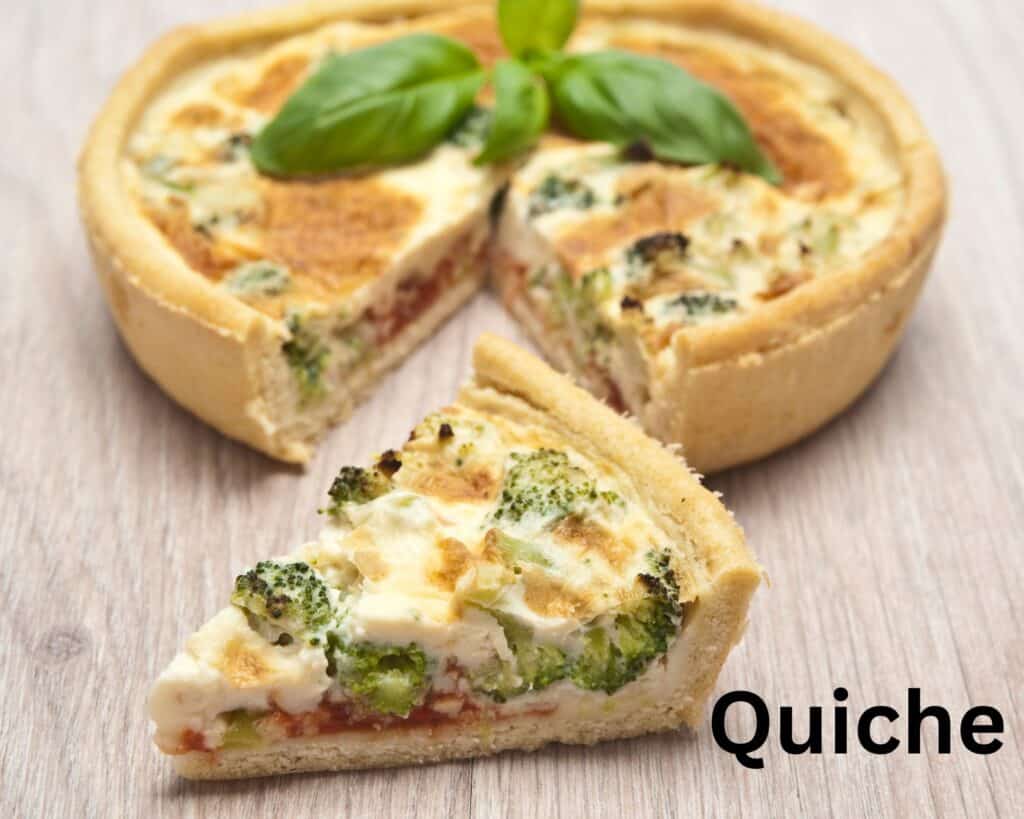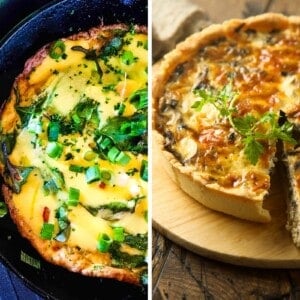Frittatas and quiches are both savory dishes typically made by combining eggs and dairy with a variety of fillings. These baked egg creations can be served hot or at room temperature and make a hearty addition to any breakfast, brunch, lunch, or dinner.
While they look very similar, there are some key differences in how they are prepared. In this article, we dig into everything you want to know about what makes these delicious egg dishes different, how to prepare them, and what to serve them with.

What is frittata?
A frittata is an Italian egg dish that is typically started in a skillet stovetop and finished in the oven until golden-brown. The word “frittata” comes from “friggere,” an Italian word meaning “to fry.”
What fillings are good in a frittata?
Frittata is a great recipe for cleaning out the fridge because you can put pretty much anything in it. Some common fillings include vegetables—from broccoli and cauliflower to greens, tomatoes, and olives—as well as cheese, meats, and seafood.
Is a frittata just an omelet?
A frittata certainly resembles an omelet, and both can use similar ingredients. One notable difference is that while a frittata starts on the stovetop (filling first), it’s finished in the oven. If making an omelet, the eggs start cooking first, and the fillings are folded in later.
Is it possible to make dairy-free or vegan frittata?
Yes! To make a dairy-free omelet, simply replace the dairy milk with a non-dairy alternative. Coconut and almond milk work well due to higher fat contents (similar to dairy).
While less conventional, it’s also possible to make a vegan frittata using a variety of vegan ingredients, such as silken tofu, chickpea flour, and nutritional yeast. Here’s a tasty vegan and gluten-free frittata recipe from Simple Veganista.
How to cook frittata
To make a frittata, you’ll begin by beating eggs with your milk of choice and then pouring this mixture over the filling ingredients. Fillings, like vegetables and meat, should be cooked first and drained of excess moisture.
The mixture and fillings are then heated in a skillet on the stovetop (without mixing, folding, or flipping) before being placed into the oven to finish cooking and brown on top. It is possible to skip the stovetop step and simply bake the egg mixture and filling ingredients in the oven until firm.
Tips for the perfect fluffy frittata
A frittata will naturally deflate a bit after coming out of the oven as the air bubbles inside pop while it cools. There are some tips to keep your frittata from deflating too much and ensuring a perfectly fluffy texture:
- Add milk. The fats and protein from milk, especially dairy, really help to make a light and fluffy frittata. It’s important not to add too much moisture, though, as this causes large air bubbles to form and pop when cooling (meaning you wind up with a flat, albeit yummy, frittata.)
- Don’t overbeat your eggs. When beating the eggs and milk, make sure they are just blended. Overbeating will introduce too much air into the mix, and, once again, your frittata wil deflate while it cools.
- Bake only until it’s set. Because your hot frittata will continue to cook as it cools, you should remove it when it’s just set. It should still wiggle a bit in the center but it should not be liquid.
What to serve with frittata?
Pairings for frittata will depend on what meal you are using it for—because frittata is yummy all day long! Since there’s no crust, you can pair with breads, toast, or baked goods. Rice or quinoa are great alternatives to bread as well.
Fresh greens or a raw veggie salad are great compliments to the thick and hearty frittata. You can also serve with roasted cherry tomatoes or other cooked vegetables, such as a simple roasted medley or steamed spinach. Fruit salad is also great!
If there’s no meat in your frittata, you can serve alongside some bacon or a cold chicken salad. For lunch and dinner, it pairs nicely with soup as well. You can’t go wrong!
Best frittata recipe
Ready to give a flavorful and nutritious frittata a go? Check out our Southwest chicken frittata recipe for a veggie and protein-packed menu item that your whole family will love!

What is quiche?
Quiche is essentially a savory egg pie. A staple of French cuisine, the basis of quiche is eggs whisked with dairy and other toppings and then baked. Where it differs most from frittata is that there’s a delicious, flakey crust holding it all together.
What fillings are good in a quiche?
Just like a frittata, quiche is so versatile in terms of fillings. It’s almost like making a pizza—once you have your base, add whatever suits your fancy! Vegetables, various cheeses, meats, and seafood are popular quiche fillings. Use whatever you’ve got!
Is it possible to make dairy-free, gluten-free, or vegan quiche?
Yes again! You can make a dairy-free or vegan quiche by making the same substitutions you’d make for a dairy-free or vegan frittata: replace the milk with a non-dairy alternative and replace the eggs with a combination of tofu, nutritional yeast, and chickpea flour. This vegan quiche recipe from Good Food is a great option!
To keep it gluten-free, simply use a recipe for gluten-free crust, like this one from The Bojon Gourmet.
How to cook quiche
A notabe difference between cooking quiche and frittata is that you have to bake a crust for quiche. Once the crust is prepared, whisk the eggs with your milk of choice and pour over your fillings. Just like frittata, filling ingredients should be cooked before baking so they don’t release too much moisture into the egg mixture.
Pour the filing and egg mixture into the par-baked crust and bake in the oven until the egg is firm.
Tips for the perfect quiche
Here are some pro-tips for making sure your quiche is perfectly creamy and delicious.
- Get your ratios down. Quiche uses more liquid per egg than frittata does, which gives it its creamy texture. As a general rule, use half a cup of milk for every egg in a quiche.
- Make a thick crust. Because a quiche can be a bit wet and heavy, it’s a good rule to make a thick crust so it holds up. Using a pre-made crust is a great shortcut!
- Precook your filing. Once again, it’s important to cook veggies and meat before baking your quiche. This ensures they will cook through and prevents them from releasing too much moisture into your quiche.
- Don’t overfill. The creamy egg mixture is definitely the star of a quiche, so it’s important not to overstuff it with other ingredients. Add extra veggies and meats as side options!
What to serve with quiche?
Just like frittata, quiche is yummy with just about anything! Since it has a crust, you can skip the breads and baked goods (or, in true French fashion, don’t skip the baked goods!) Serve alongside fruit or raw vegetable salads to keep things light or meat dishes for extra protein. Quiche also pairs really nicely with soups.
Best quiche recipe
Now that your mouth is watering for quiche, give our spinach, mushroom, and asiago quiche a try! This light and healthy quiche is simple yet full of all the right flavors and is ready in an hour.

What’s the difference between frittata and quiche?
Both of these classic egg-bake dishes are hearty and incredibly versatile. They share the same toppings and pair well with similar items, whether you’re serving them for breakfast, lunch, or dinner. But there are some key differences when looking at quiche vs frittata:
- Crust: Perhaps the most notable difference is that quiche has a crust while frittata does not.
- Liquid-to-egg ratio: Quiche contains fewer eggs and more cream or milk compared to a frittata.
- Texture: The higher liquid to egg ratio in a quiche gives it a creamier, custard-like texture. Frittata is less creamy and fluffier than quiche.
- Cooking method: Frittata is traditionally started on the stovetop and then baked, while a quiche is simply baked.
Related Recipes
Looking for more egg-cellent breakfast and brunch options? Use up your extra quiche in these delightful spinach and feta breakfast sandwiches or head over to our 21 brunch ideas roundup for more ideas to wow your guests!
Frequently Asked Questions (FAQs)
Q1: Can you bake a frittata in a glass dish?
A: Yes, you can bake frittata in a glass dish. Make sure you know the maximum temperature for your glassware so it doesn’t break.
Q2: Is a frittata just a crustless quiche?
A: A frittata is a crustless quiche, with some other notable differences. The texture of each is different due to differences in egg to liquid ratios. A quiche is more creamy while a frittata is more fluffy. Otherwise, they are quite similar.
Q3: Is a quiche or frittata healthier?
A: A frittata is generally considered healthier because it doesn’t have the extra carbs and calories that a quiche has due to its crust.
Frittata vs Quiche

Instructions
- Choose your favorite recipe
- Click the link to view the instructions
- Follow the linked instructions
- Enjoy

